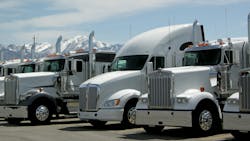Editorial: Trucking Industry in Holding Pattern
As a barometer of the economy’s overall health, the trucking industry has always served as a “canary in the coal mine,” signaling the approach of either prosperity or foreshadowing economic downturns.
If current trucking industry metrics are any indication, the commercial transportation industry — and by extension, businesses that serve it, like commercial tire dealerships — are in for a bumpy ride during the second half of 2025.
That’s the assessment of Ken Vieth, president of ACT Research, a Columbus, Ind.-based firm that analyzes and forecasts the commercial trucking market.
“The word ‘weak’ is probably as good of a descriptor (of the U.S. trucking industry) as there is right now,” Vieth recently told me.
Uncertainty due to the start-stop cycle of tariffs that the Trump administration first imposed on April 2 has been the primary catalyst of the trucking industry’s slowdown, he said.
“Coming into 2025, for-hire truck load carriers had weak profitability, so that was problematic. But vocational markets were strong and buyers were holding course.
“Back in January 2025, our expectation for (annual) Class 8 builds in 2025, on a North American basis, was 316,000 units. By April, our forecast was down to 255,000 units. Our May forecast (was) 256,000 units.” (That’s a 19% drop in projections.)
By “builds,” Vieth means “all OEMs for all destinations from North American factories,” with the United States and Mexico being the primary points of origin.
“Going back to the beginning of the year, we thought GDP was going to grow by 2.1% in 2025,” said Vieth. “In May, our GDP forecast for the year has been marked down to 1.1%. (I interviewed Vieth in mid-May.)
“We were expecting at the beginning of the year that freight would grow around 2.7% in 2025. Our most current forecast is 1.3% freight growth. The good news is that rates are off the floor that they’ve been on for the past three years. But they’re barely off the floor. We’ve seen a little bit of improvement, but there continues to be no traction in spot rates.”
Carrier profitability is at “generationally low levels,” according to Vieth. “In the first quarter of this year, (aggregate) net profit margins for large, well-run carriers — think Knight, J.B. Hunt, Werner, those folks — fell to a 15-year low, to about 2.7%.
You would have to go all the way back to the first quarter of 2010” to see similar numbers. “That’s how bad it is for for-hire carriers,” which, he added, had already been losing share to private fleets like Amazon and Walmart.
“Coming into 2025, the debate here was, ‘How strong will the economy be in 2025?’ as opposed to ‘How weak will the economy be in 2025?’ Along with lowering our expectations for GDP growth, we’ve pushed our expectation for recovery of freight rates from the second half of 2025 to the second half of 2026.
“Uncertainty is not good for any business,” said Vieth. “I (recently) gave a presentation at the National Private Truck Council. Almost as soon as I was done, (the Trump administration announced), ‘We have a deal to pause some of the tariffs from China.’ How do you make investment decisions when the ground you’re walking on is constantly changing?
“It’s hard to come up with many bright spots right now,” Vieth told me. But not all is lost, he said. “If there is a silver lining, the U.S. economy was strong at the end of 2024. Consumers are still in pretty good shape.”
The problem, he pointed out, is that consumer confidence is “eroding,” a trend that could be alleviated “if the (government) would pull back on some of these tariffs. It’s hard to invest in the unknown. Everybody’s waiting and seeing.”
That includes several commercial tire dealers I’ve heard from in recent weeks. One dealer told me that the market “feels volatile.” Another told me “there’s a lot of uncertainty” among his customers. “We’ve seen considerable shrinkage” in the over-the-road trucking segment, one dealer revealed. “Everyone is tightening their belts,” yet another reported.
But all of these dealers see opportunities, as well — from growing their retread sales as fleets seek to squeeze more miles out of their existing tires to expanding their business on the service side. And there’s the chance to “flush out” — as one dealer put it — excess or slow-moving inventory and present even more compelling reasons to shift budget-conscious clients into higher-margin brands and products.
It’s a safe bet that we’ll see slower-than-normal trucking activity in the months to come. But trucks will continue to roll. And they’ll still need high-quality tires and top-notch service, which commercial tire dealerships are in a better position to provide than anyone else. In this time of uncertainty, you can be sure of at least that.
About the Author
Mike Manges
Editor
Mike Manges is Modern Tire Dealer’s editor. A 28-year tire industry veteran, he is a three-time International Automotive Media Association Award winner, holds a Gold Award from the Association of Automotive Publication Editors and was named a finalist for the prestigious Jesse H. Neal Award, the Pulitzer Prize of business-to-business media, in 2024. He also was named Endeavor Business Media's Editor of the Year in 2024. Mike has traveled the world in pursuit of stories that will help independent tire dealers move their businesses forward. Before rejoining MTD in 2019, he held corporate communications positions at two Fortune 500 companies and served as MTD’s senior editor from 2000 to 2010.

